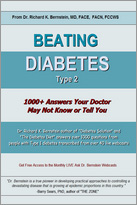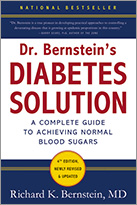 I do not know of many diabetics who developed the illness around the time I did, in 1946, who are still alive. I know of none who do not suffer from active complications. The reality is, had I not taken charge of my diabetes, it’s very unlikely that I’d be alive and active today. Many myths surround diet and diabetes, and much of what is still considered by the average physician to be sensible nutritional advice for diabetics can, over the long run, be fatal.
I do not know of many diabetics who developed the illness around the time I did, in 1946, who are still alive. I know of none who do not suffer from active complications. The reality is, had I not taken charge of my diabetes, it’s very unlikely that I’d be alive and active today. Many myths surround diet and diabetes, and much of what is still considered by the average physician to be sensible nutritional advice for diabetics can, over the long run, be fatal.
I know, because conventional “wisdom” about diabetes almost killed me.
I developed diabetes in 1946 at the age of twelve, and for more than two decades I was an “ordinary” diabetic, dutifully following doctor’s orders and leading the most normal life I could, given the limitations of my disease.
Over the years, the complications from my diabetes became worse and worse, and like many diabetics in similar circumstances, I faced a very early death. I was still alive, but the quality of my life wasn’t particularly good. I have what is known as type 1, or insulin-dependent, diabetes, which usually begins in childhood (it’s also called juvenileonset diabetes). Type 1 diabetics must take daily insulin injections just
to stay alive.
Back in the 1940s, which were very much still the “dark ages” of diabetes treatment, I had to sterilize my needles and glass syringes by boiling them every day, and sharpen my needles with an abrasive stone. I used a test tube and an alcohol lamp (flame) to test my urine for sugar. Many of the tools the diabetic can take for granted today were scarcely dreamed of back then — there was no such thing as a rapid, finger-stick blood sugar–measuring device, nor disposable insulin syringes. Still, even today, parents of type 1 diabetics have to live with the same fear my parents lived with—that something could go disastrously wrong and they could try to wake up their child and discover him comatose, or worse. For any parent of a type 1 diabetic, this has been a real and constant possibility.
Because of my chronically elevated blood sugar levels, and the inability to control them, my growth was stunted, as it is for many juvenile-onset diabetics even to this day.
Back then, the medical community had just learned about the relationship between high blood cholesterol and vascular (blood vessel and heart) disease. It was then widely believed that the cause of high blood cholesterol was consumption of large amounts of fat. Since many diabetics, even children, have high cholesterol levels, physicians were beginning to assume that the vascular complications of diabetes—heart disease, kidney failure, blindness, et cetera—were caused by the fat that diabetics were eating. As a result, I was put on a low-fat, high-carbohydrate diet (45 percent of calories were to be carbohydrates) before such diets were advocated by the American Diabetes Association or the American Heart Association. Because carbohydrate raises blood sugar, I had to compensate with very large doses of insulin, which I injected with a 10 cc “horse” syringe. These injections were slow and painful, and eventually they destroyed all the fatty tissue under the skin of my thighs. In spite of the low-fat diet, my blood cholesterol became very high. I developed visible signs of this state—fatty growths on my eyelids and gray deposits around the iris of each eye.
During my twenties and thirties, the prime of life for most people, many of my body’s systems began to deteriorate. I had excruciatingly painful kidney stones, a stone in a salivary duct, “frozen” shoulders, a progressive deformity of my feet with impaired sensation, and more. I would point these out to my diabetologist (who was then president of the American Diabetes Association), but I was inevitably told, “Don’t worry, it has nothing to do with your diabetes. You’re doing fine.” But I wasn’t doing fine. I now know that most of these problems are commonplace among those whose diabetes is poorly controlled, but then I was forced to accept my condition as “normal.”
By this time I was married. I had gone to college and trained as an engineer. I had small children, and even though I was not much more than a kid myself, I felt like an old man. I had lost the hair on the lower parts of my legs, a sign that I had developed peripheral vascular disease—a complication of diabetes that can eventually lead to amputation.
During a routine exercise stress test, I was diagnosed with cardiomyopathy, which is a replacement of muscle tissue in the heart with fibrous (scar) tissue—a common cause of heart failure and death among those with type 1 diabetes.
Even though I was “doing fine,” I suffered a host of other complications. My vision deteriorated: I suffered night blindness, microaneurysms (ballooning of the blood vessels in my eyes), macular edema (swelling of the central portion of my retinas), and early cataracts. Just lying in bed caused pain in my thighs, due to a common but rarely diagnosed and barely pronounceable diabetic complication called iliotibial band/tensor fascialata syndrome. Putting on a T-shirt was agonizing because of my frozen shoulders.
I had begun testing my urine for protein and found substantial amounts of it, a sign, I had read, of advanced kidney disease. In those days—the middle and late 1960s—the life expectancy of a type 1 diabetic with proteinuria was five years. Back in engineering school, a classmate had told me how his nondiabetic sister had died of kidney disease. Before her death she had ballooned with retained water, and after I discovered my own proteinuria, I began to have nightmares of blowing up like a balloon.
By 1967 I had these and other diabetic complications and clearly appeared chronically ill and prematurely aged. I had three small children, the oldest only six years old, and with good reason was certain I wouldn’t live to see them grown.
At my father’s suggestion, I started working out daily at a local gym. He thought that if I were to engage in vigorous exercise, I might feel better. Perhaps exercise would help my body help itself. I did feel slightly less depressed about my condition—at least I felt I was doing something—but I couldn’t build muscles or get much stronger.
After two years of pumping iron, I remained a 115-pound weakling, no matter how strenuously I worked out. It was at about this time, in 1969, that my wife, a physician, pointed out to me that I had spent much of my life going into, experiencing, or recovering from hypoglycemia, which is a state of excessively low blood sugar. It was usually accompanied by fatigue and headaches, and was caused by the unpredictable action of the large doses of insulin I was taking to cover my high-carbohydrate diet. During such episodes, I became confused and unruly and snapped at people. These frequent hypoglycemic episodes had taken their toll upon my parents, and were taking their toll upon my wife and children. The strain on my family was clearly becoming untenable.
Suddenly, in October of 1969,my life turned around.
I had been the research director of a company that made equipment for hospital laboratories, but recently I had taken a new job as an officer of a housewares corporation. I was still receiving trade journals from my old field, and one day I opened the latest issue of a publication called Lab World. I came upon an advertisement for a new device to help hospital emergency rooms distinguish between unconscious diabetics and unconscious drunks during the night, when laboratories were closed. Knowing that an unconscious person was a diabetic and not drunk could easily help hospital personnel save his life. What I stumbled upon was an ad for a blood sugar meter that would give a reading in 1 minute, using a single drop of blood.
Since I’d been experiencing many blood sugars that were too low, and since the tests I had been performing on my urine were wholly inadequate (sugar that shows up in the urine is already on its way out of the bloodstream), I figured that if I knew what my blood sugars were, perhaps I could catch and correct my hypoglycemic episodes before they made me disoriented and irrational.
I marveled over the instrument. It had a 4-inch galvanometer with a jeweled bearing, weighed 3 pounds, and cost $650. I tried to order one, but the manufacturer wouldn’t sell it to patients, only to doctors and hospitals.
Fortunately, my wife, as I’ve said, was a physician, so I ordered one in her name. I started to measure my blood sugar about 5 times each day, and soon saw that the levels were on a roller coaster. Engineers are accustomed to solving problems mathematically, but you have to have information to work with. You have to know the mechanics of a problem in order to solve it, and now, for the first time, I was gaining insight into the mechanics and mathematics of my disease. What I learned from my frequent testing was that my own blood sugars swung from lows of under 40 mg/dl to highs of over 400 mg/dl about twice daily. A normal blood sugar level is about 85 mg/dl.* Small wonder I was subject to such vast mood swings.
Although most medical journals and textbooks throughout the world measure blood glucose in mmol/l (millimoles per liter), most physicians, laboratories, and blood glucose meters in the United States measure blood glucose in mg/dl.
In an effort to level my blood sugars, I began to adjust my insulin regimen, and went from one injection a day to two. I made some experimental modifications to my diet, cutting down on the carbohydrates to permit me to take less insulin. The very high and low blood sugar levels became less frequent, but few were normal.
Three years after I started measuring my blood sugar levels, my diabetic complications were still progressing, and I was still a 115-pound weakling. My sense of gaining insight into the long-term complications of my diabetes had diminished, and so I ordered a computer search of the scientific literature to see if exercise could prevent diabetic complications. In those days, computer searches were not the simple, almost instant searches they are today. In 1972 you made your request to the local medical library, which mailed it to Washington, D.C., where it was processed. It took about two weeks for my $75 printout to arrive.
There were quite a few entries of interest, and I ordered copies of the original articles. For the most part these were from esoteric journals and dealt with animal experiments. The information I had hoped to find didn’t exist. I didn’t find a single article pertaining to the prevention of diabetic complications by exercise.
What I did find was that such complications had repeatedly been prevented, and even reversed, in animals.Not through exercise, but by normalizing blood sugars! To me, this was a total surprise. All of diabetes treatment was heavily focused in other directions, such as lowfat diets, preventing severe hypoglycemia, and preventing a potentially fatal extreme high blood sugar condition called ketoacidosis. Thus it had not occurred to me that keeping blood sugar levels as close to normal as possible for as much of the time as possible would make a difference.
Excited by my discovery, I showed these reports to my physician, who was not impressed. “Animals aren’t humans,” he said, “and besides, it’s impossible to normalize human blood sugars.” Since I had been trained as an engineer, not as a physician, I knew nothing of such impossibilities, and since I was desperate, I had no choice but to pretend I was an animal.
I spent the next year checking my blood sugars 5–8 times each day.
Every few days, I’d make a small, experimental change in my diet or insulin regimen to see what the effect would be on my blood sugar. If a change brought an improvement, I’d retain it. If it made blood sugars worse, I’d discard it. I discovered that 1 gram of carbohydrate raised my blood sugar by 5 mg/dl, and ½ unit of the old beef/pork insulin lowered it by 15 mg/dl (milligrams per deciliter). Blood glucose values in this book are as a rule given in mg/dl. If you should need to translate from one to the other, 1 mmol/l = 18 mg/dl.
Within a year, I had refined my insulin and diet regimen to the point that I had essentially normal blood sugars around the clock. After years of chronic fatigue and debilitating complications, almost overnight I was no longer continually tired or “washed out.” People commented that my gray complexion was gone. After years of skyhigh readings, my serum cholesterol and triglyceride levels had now not only dropped, but were at the low end of the normal ranges.
I started to gain weight, and at last I was able to build muscle as readily as nondiabetics. My insulin requirements dropped to about one-third of what they had been a year earlier. With the subsequent development of human insulin, my dosage dropped to less than onesixth of the original. The painful, slow-healing lumps the injections of large doses of insulin left under my skin disappeared. The fatty growths on my eyelids from high cholesterol vanished. My digestive problems (chronic burning in my chest and belching after meals) and the proteinuria that had so worried me eventually vanished. Today,my results from even the most sensitive kidney function tests are all normal.
The cystoid macular edema that I thought as recently as twelve years ago was irreversible has finally reversed. My deformed feet, the calcified walls of arteries in my legs, and the loss of hair on my lower legs are not reversible and still remain.
I had the new sensation of being the boss of my own metabolic state, and began to feel the same sense of accomplishment and reward I had in engineering when I solved a difficult problem. I had taught myself how to make my blood sugars whatever I wanted them to be and was no longer on the roller coaster. Things were finally under my control.
Back in 1973, I felt quite exhilarated with my success, and I felt that I was on to something big. Since getting the results of my computer search, I had been a subscriber to all of the English-language diabetes journals, and none of them had mentioned the need for normalizing blood sugars in humans.
In fact, every few months I’d read another article saying that blood sugar normalization wasn’t even remotely possible. How was it that I, an engineer, had figured out how to do what was impossible for medical professionals? I was deeply grateful for the fortuitous combination of events that had turned my life, my health, and my family around and put me on the right path. At the very least, I felt, I was obliged to share my new found knowledge with others. Millions of “ordinary” diabetics were no doubt suffering needlessly, as I had. I was sure that all physicians treating diabetes would be thrilled to learn how to prevent and possibly reverse the grave complications of this disease.
I hoped that if I could tell the world about the techniques I had stumbled upon, physicians would adopt them for their patients. So I wrote an article detailing my discoveries. I sent a copy to Charles Suther, who was then in charge of marketing diabetes products for Ames Division of Miles Laboratories, the company that made my blood glucose meter. He gave me the only encouragement I received in this new venture, and arranged for one of his company’s medical writers to edit the article for me.
I submitted it and its revisions to many medical journals over a period of years—a period during which I was continually improving in health, and continually proving to myself and my family, if to no one else, that my methods were correct. The rejection letters I received are testimony that people tend to ignore the obvious if it conflicts with the orthodoxy of their early training. Typical rejection letters read in part: “Studies are not unanimous in demonstrating a need for ‘fine control’” (the New England Journal of Medicine), or “How many patients would use the electric device for measurement of glucose, insulin, urine, etc.?” (Journal of the American Medical Association). As a matter of fact, since 1980, when these “electric devices” finally were made available to patients, the worldwide market for blood glucose self monitoring supplies has come to exceed $4 billion annually. Look at the array of blood glucose meters in any pharmacy and you can get an idea of just how many patients use, and will use, the “electric device.”
Trying to cover several routes simultaneously, I joined the major lay diabetes organizations, in the hope of moving up through the ranks, where I could get to know physicians and researchers specializing in the disease. This met with mediocre success. I attended conventions, worked on committees, and became acquainted with many prominent diabetologists. In this country, I met only three physicians who were willing to offer their patients the opportunity to put these new methods to the test.
Meanwhile, Charlie Suther was traveling around the country to university research centers with copies of my unpublished article, which by now had been typeset and privately printed at my expense.
The rejection by physicians specializing in diabetes of the concept of blood sugar self-monitoring, even though essential to blood sugar control, was so intense, however, that the management of his company had to turn down the idea of making meters available to patients until many years later. His company and others could clearly have profited from the sale of blood glucose meters and test strips. However, the backlash from the medical establishment prevented it on a number of counts. It was unthinkable that patients be allowed to “doctor” themselves.
They knew nothing of medicine—and if they could, how would doctors earn a living? In those days, patients visited their doctors once a month to “get a blood sugar.” If they could do it at home for 25 cents (in those days), why pay a physician? But almost no one believed there was any value to normal blood sugars anyway. In some respects, blood glucose self-monitoring still remains a serious threat to the incomes of many physicians who specialize in the treatment of the symptoms of diabetes and not the disease. Drop into your neighborhood ophthalmologist’s office and you will find the waiting room three-quarters filled with diabetics, many of whom are waiting for expensive fluorescein angiography or laser treatment.
With Suther’s backing in the form of free supplies, by 1977 I was able to get the first of two university-sponsored studies started in the New York City area. These both succeeded in reversing early complications in diabetic patients. As a result of our successes, the two universities separately sponsored the world’s first two symposia on blood glucose self-monitoring. By this time I was being invited to speak at international diabetes conferences, but rarely at meetings in the United States. Curiously, more physicians outside the United States seemed interested in controlling blood sugar than did their American colleagues. Some of the earliest converts to blood glucose self-monitoring
were from Israel and England.
By 1978, perhaps as a result of Charlie Suther’s efforts, a few additional American investigators were trying our regimen or variations of it. Finally, in 1980, manufacturers began to release blood glucose meters for use by patients.
This “progress” was entirely too slow for my liking. I knew that while the medical establishment was dallying there were diabetics dying whose lives could have been saved. I knew also that there were millions of diabetics whose quality of life could be vastly improved. So in 1977 I decided to give up my job and become a physician—I couldn’t beat ’em, so I had to join ’em. This way, with an M.D. after my name, my writings might be published, and I could pass on what I had learned about controlling blood sugar.
After a year of premed courses and another year of waiting, I entered the Albert Einstein College of Medicine in 1979. I was forty-five years old. During my first year of medical school I wrote my first book, Diabetes: The Glucograf Method for Normalizing Blood Sugar, enumerating the full details of my treatment for type 1, or insulin-dependent, diabetes.
In 1983 I finally opened my own medical practice near my home in Mamaroneck, New York. By that time, I had well outlived the life expectancy of an “ordinary” type 1 diabetic. Now, by sharing my simple observations, I was convinced I was in a position to help both type 1 and type 2 diabetics who still had the best years of their lives ahead of them. I could help others take control of their diabetes as I had mine, and live long, healthy, fruitful lives.
The goal of this book is to share the techniques and treatments I have taught my patients and used on myself, including the very latest developments. If you or a loved one suffers from diabetes, I hope this book will give you the tools to turn your life around as I did mine.




